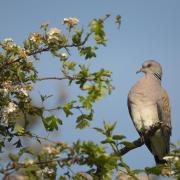Our vast and varied coastline is a treasure trove for wildlife, whether you’re into bird watching, rock pooling, fishing or walks
Summer has finally arrived and what better place to spend it than on England’s longest and most geologically diverse coastline?
But before you head out to the traditional resorts of, say, Thanet or Folkestone, why not consider these less obvious destinations, which just happen to be among Kent’s best nature reserves.
Whether it’s bird watching, fishing, rockpooling or simply a bracing walk that you crave, let Kent Wildlife Trust take you on a snapshot tour of our coastal ‘hotspots’ for wildlife.
Oare Marshes (ME13 0QA)
This internationally recognised reserve for birds offers plenty of spectacular viewing points and it’s where seals can be seen basking on the mud banks in the middle of the Swale estuary.
From the causeway at the sea’s edge at low tide you can watch small fish dart around the seaweeds and mussels. Look out for the salt marsh, a specialised environment where plants need to survive inundation from the tides.
These marshes are riddled with sinuous creek systems, a hidden world of crustaceans, worms and molluscs providing meals for the thousands of visiting birds. At the marsh’s edge, from July to September, you can admire the shimmering pink-purple sea lavender and golden samphire.
Reculver (CT6 6SS)
The country park, dominated by the ancient twin towers of St. Mary’s Church, is awash with wildlife. On the upper shore, there are edible and shore crabs under almost every rock, as well as tiny fish, prawns and colourful sea anemones.
On the lower shore you’ll find bountiful spider crabs, bright orange, red and yellow sponges, sea squirts and striped or spotty sea slugs. Even the cliffs contain plenty of life, with their very crumbly sandstone structure ideal for nesting sand martins and colonies of miner bees.
If you’re lucky and sharp eyed, shark’s teeth fossils can be found at the tide’s edge, as well as fossilised ancient shells in the sandstone boulders.
And don’t forget to pop into the Visitor Centre to pick up a wealth of information on this fascinating region.
Sandwich & Pegwell Bay (CT12 5JB)
The reserve is a complex mosaic of habitats and internationally important for birds. Our marine surveys have revealed 179 different species, from barnacles to bivalves, sponges to seaweeds.
Explore the top of the beach where the strandlines are full of seaweed and debris brought up by the highest tides.
You might be lucky enough to see mermaid’s purses, dog whelk eggs and cuttlebones, as well as small mobile crustaceans such as the sand-hopper.
From the bottom of the shingle beach extending onto the mud flats are strandlines that often contain drifts of razor shells, colourful scallop shells and a wide variety of other bivalves and gastropods.
The antics of a flourishing seal colony can also be observed from the reserve.
Romney Warren (TN28 8AY)
Finally, no exploration of Kent’s seaside would be complete without a visit to the magical, mystical Marsh. You’ll find all the information you need on the region’s wildlife and history at the eco-friendly Romney Marsh Visitor Centre, now celebrating its 10th year.
The Warren, an ecologically important dune grassland nature reserve, is home to rare flora, mosses, lichens and medicinal leeches and its ponds hold nationally important populations of great crested newts and great silver beetles. n



























